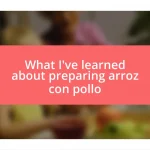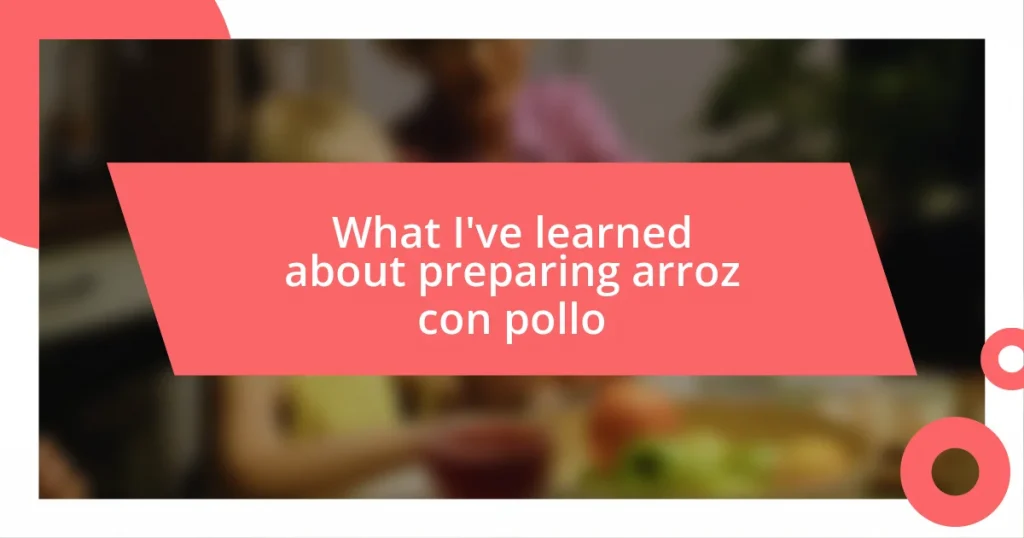Key takeaways:
- Open-fire cooking fosters a deep connection with nature and enhances communal experiences, turning meals into lasting memories.
- Essential tools include a solid griddle or cast iron skillet, long-handled utensils, and a fire pit or portable grill for safe and effective cooking.
- Prioritize safety by maintaining distance from flammable objects, having fire-extinguishing tools handy, and wearing appropriate, fitted clothing.
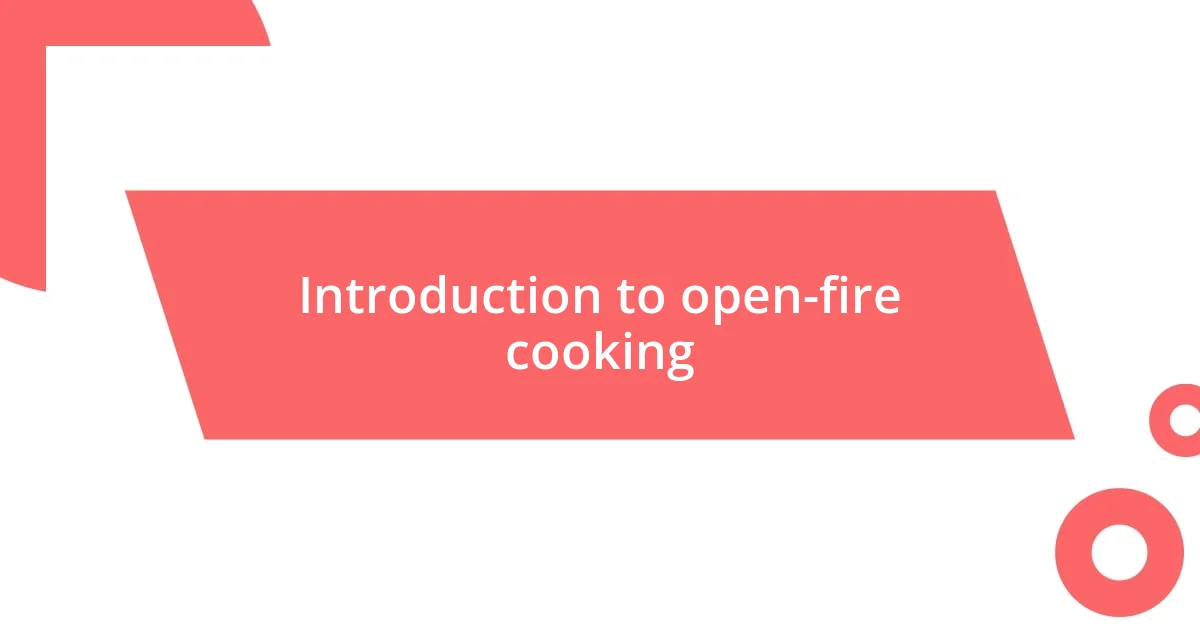
Introduction to open-fire cooking
Open-fire cooking is an ancient art that connects us to our primal instincts. I remember the first time I cooked over an open flame; the aroma of the woodsmoke mingling with the food created a nostalgic feeling, almost like being wrapped in a warm blanket of memories. Have you ever felt that rush when the flames dance and crackle, igniting a sense of adventure?
There’s something inherently magical about preparing a meal outdoors, where the elements play their part in the cooking process. I still cherish the moments spent with friends, huddled around a fire, sharing stories and laughter as we waited for our food to cook. The camaraderie that develops in those shared experiences can elevate a simple meal into an unforgettable feast, can’t it?
Cooking over flames is not just about the food; it’s an invitation to reconnect with nature. Each time I step outside to fire up a grill or set up a campfire, I feel invigorated, as if I’m part of something much larger than myself. It’s a reminder of where our food comes from and a joyful celebration of the simple things in life.
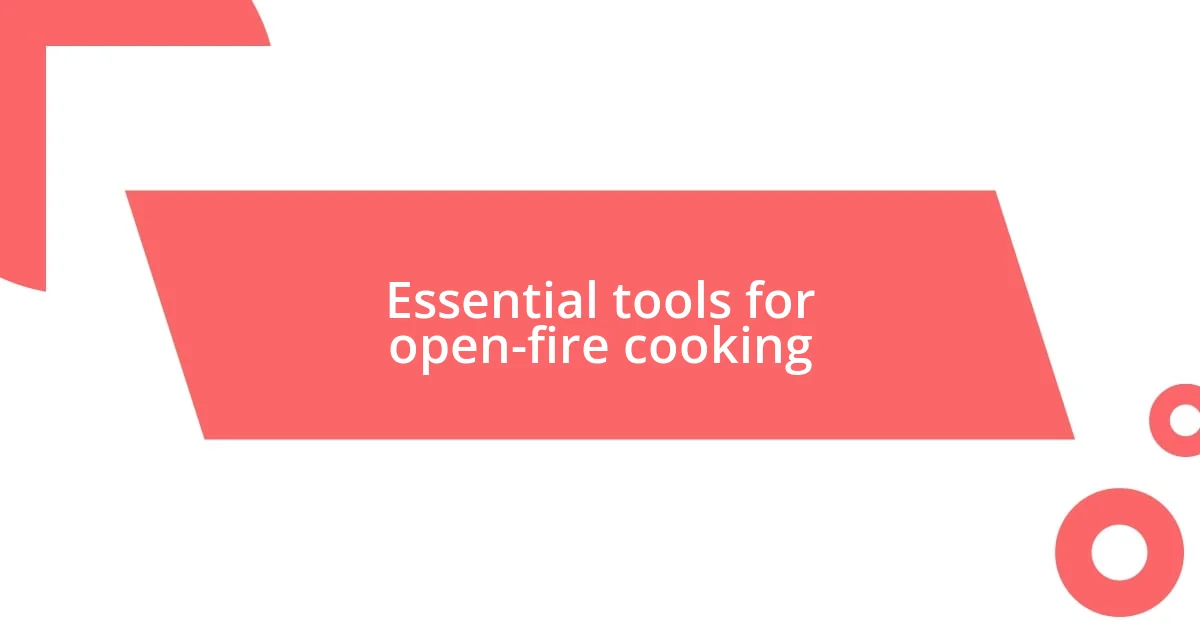
Essential tools for open-fire cooking
When it comes to open-fire cooking, having the right tools can make all the difference. I’ve found that a solid griddle or cast iron skillet is essential for versatility. They not only withstand high heat but also provide an even cooking surface for everything from pancakes to sautéed vegetables. The first time I flipped a perfectly golden pancake over the flames, I felt like a true culinary wizard.
Another tool that I can’t recommend enough is a good set of long-handled utensils. Trust me, there’s nothing enjoyable about leaning over the fire to flip your food. My favorite spatula has a sturdy grip, allowing me to maneuver dishes effortlessly while keeping a safe distance from the heat. It’s made those late-night gatherings with friends much more comfortable, as we disrupt the dancing embers with laughter instead of smoke from flailing arms!
Lastly, a fire pit or portable grill is crucial to safely contain the flames while cooking. I still remember my first campfire barbecue; the thrill of seeing the flames leap and flicker against the night sky had an almost hypnotic allure. These tools are my ticket to flavor and adventure, transforming cooking into an experience that nourishes both body and spirit.
| Tool | Purpose |
|---|---|
| Griddle/Cast Iron Skillet | Versatile cooking surface, good for high heat |
| Long-Handled Utensils | Keep distance from flames, easy maneuvering |
| Fire Pit/Portable Grill | Safe space for flames, enhances cooking experience |

Selecting the right firewood
Selecting the right firewood is crucial for achieving that perfect open-fire cooking experience. Over the years, I’ve experimented with various types of wood, and I can confidently say that each type brings a unique flavor to the food. For example, the first time I cooked with hickory, I was pleasantly surprised by the smoky richness it added to my ribs; it transformed the dish into something truly memorable. Not all woods are created equal, and understanding their properties can elevate your cooking.
Here are some key points to consider when selecting firewood:
– Types of Wood: Different woods release different flavors. Hardwoods like oak, maple, and hickory provide a long-lasting, hot burn, perfect for grilling.
– Seasoned vs. Green Wood: Always choose seasoned wood that has dried for at least six months; it burns better and produces less smoke. Green wood can lead to excessive sparks and a sooty mess.
– Wood Size: Split your firewood into smaller pieces for better airflow and quicker ignition. I’ve learned that smaller logs catch fire much more easily, ensuring a consistent flame.
– Avoid Certain Woods: Some woods, like evergreens, can produce a lot of smoke and resin, which can impart an unpleasant taste to your food. Trust me, you don’t want your grilled salmon tasting like a Christmas tree!
Choosing the right firewood may seem simple, but it truly impacts the cooking process and the flavors in your dishes. Remember that the wood you select is like the seasoning for your fire; it enhances your meal in ways you might not expect.
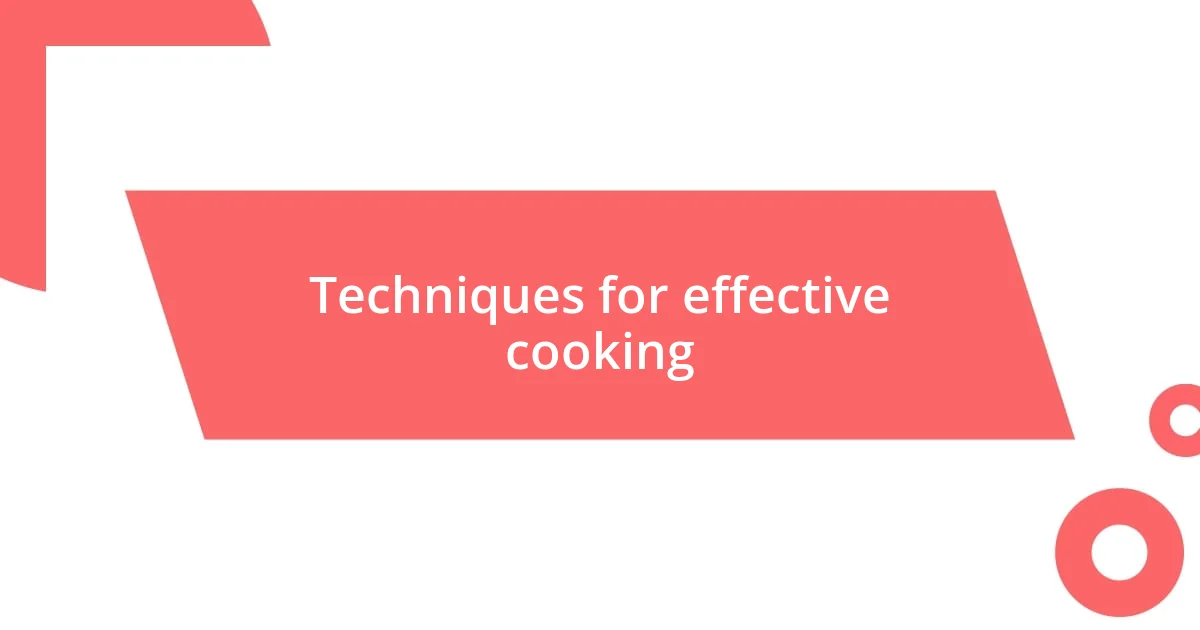
Techniques for effective cooking
When cooking over an open fire, mastering heat control is paramount. I’ve often found myself adjusting the fire’s intensity by managing the placement of the logs; sometimes, I’ll shove them closer together for a hotter blaze or fan them out for a gentler warmth. It’s a bit like dancing; finding the right rhythm is essential to avoid scorching your food while still achieving that delightful char. Has anyone else felt the anxiety of biting into something, only to discover it’s raw in the middle?
Another technique that I swear by is flipping and rotating food regularly. The first time I grilled corn on the cob, I left it too long without turning, and it burnt on one side. The lesson? Keep your food moving for even cooking and the best flavor. Constantly turning your food not only prevents it from burning but also allows those lovely flavors from the wood to be evenly distributed, making every bite a delight.
Finally, don’t underestimate the power of patience—great things take time! I remember anxiously waiting for a whole chicken to roast over the fire, tempted to peek every few minutes. But each time I exhibited that patience, the reward was golden, juicy perfection. The aroma wafting through the air felt like a celebration that was worth every moment of waiting. There’s a unique satisfaction in cooking this way, as it invites connection—not just with the food, but with nature and the people around you.
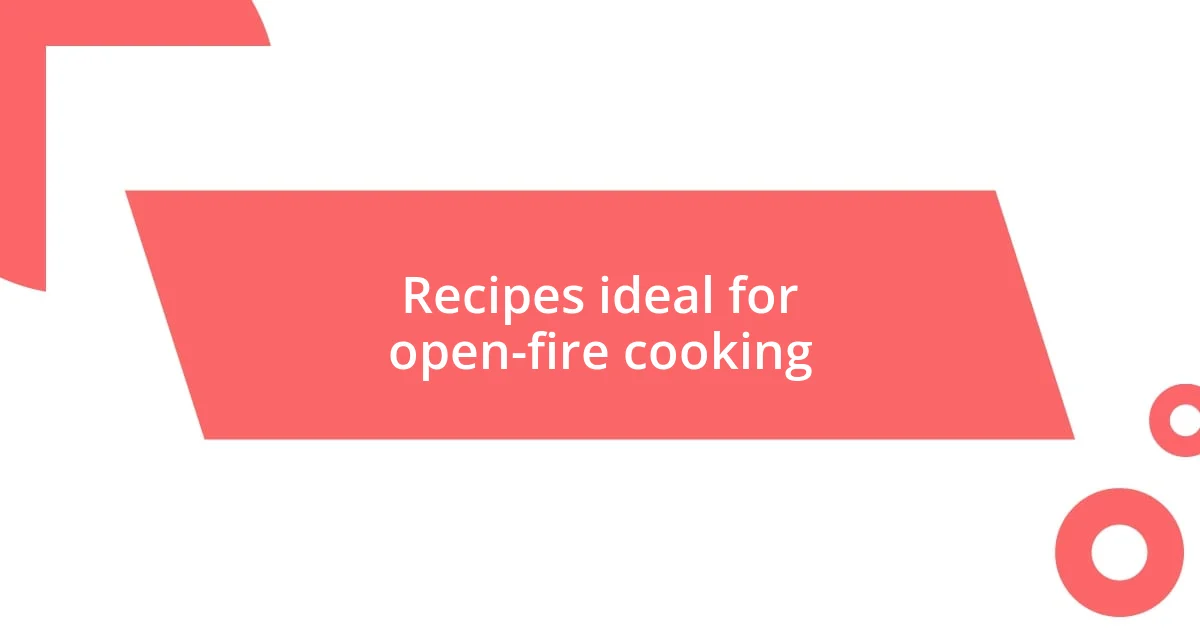
Recipes ideal for open-fire cooking
When it comes to recipes for open-fire cooking, one of my all-time favorites is roasted vegetables. I remember the first time I tossed some bell peppers, zucchini, and mushrooms in a simple olive oil and garlic marinade before skewering them. As they danced over the flames, the smell enveloped me, instantly making me feel both hungry and nostalgic for family camping trips. Just a touch of salt and a squeeze of lemon after cooking brings out their natural sweetness, making for a vibrant, flavorful side dish.
Another delectable choice is a classic cast-iron skillet pizza. I still chuckle when I think about my first attempt: I had the dough ready but thought I’d set the skillet directly on the coals. It was a charred disaster! However, after learning to elevate the skillet, creating a convection effect, my pizzas transformed into golden, cheesy masterpieces. It’s fascinating how a simple adjustment can take something from a flop to a flavor triumph. What about you? Have you ever encountered a cooking mishap that turned into a breakthrough?
If you’re looking for something more indulgent, try open-fire s’mores with a twist. Instead of the usual graham crackers, I substitute them with thin slices of pound cake. The first time I served these, the kids’ eyes lit up as they toasted marshmallows to gooey perfection. Then, sandwiching the warm marshmallow and chocolate between the cake was an absolute game-changer. The added flavor and texture make them feel more special—perfect for those cozy nights by the fire. Who can resist that crispy, sweet exterior? In every recipe, there’s an opportunity not just to cook but to create lasting memories.
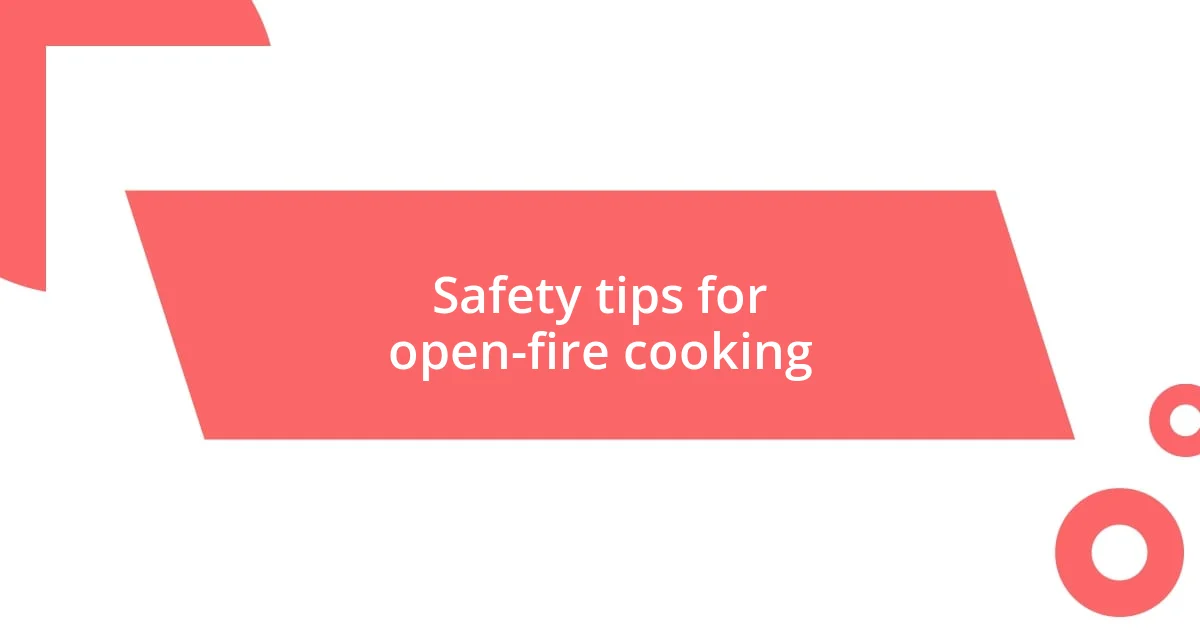
Safety tips for open-fire cooking
When it comes to open-fire cooking, safety is a non-negotiable aspect I always prioritize. One evening, as I was preparing to roast marshmallows, I realized I had set up the fire too close to the picnic table. The last thing you want is an unexpected flare-up when you’re having fun with friends. So, always maintain a safe distance between your cooking area and any flammable objects to prevent any mishaps.
Having the right fire-extinguishing tools at hand is another vital tip. I’ve learned this lesson the hard way after a small ember floated too close to my picnic blanket during a campfire dinner. Having a bucket of water or a fire extinguisher nearby can provide peace of mind, allowing you to focus on the joyful experience of cooking over the flames instead of worrying about potential accidents. Have you ever found yourself in a similar situation?
Moreover, wearing appropriate clothing is essential. I still remember my first open-fire cooking session, where I donned a loose-fitting shirt that accidentally brushed against the flames while I was flipping some burgers. The sudden panic taught me to always stick to fitted, flame-resistant gear. It not only keeps you safe but also allows you to enjoy your open-fire cooking venture without worry, making every moment about laughter and good food. Wouldn’t you agree that feeling secure enhances your overall experience?
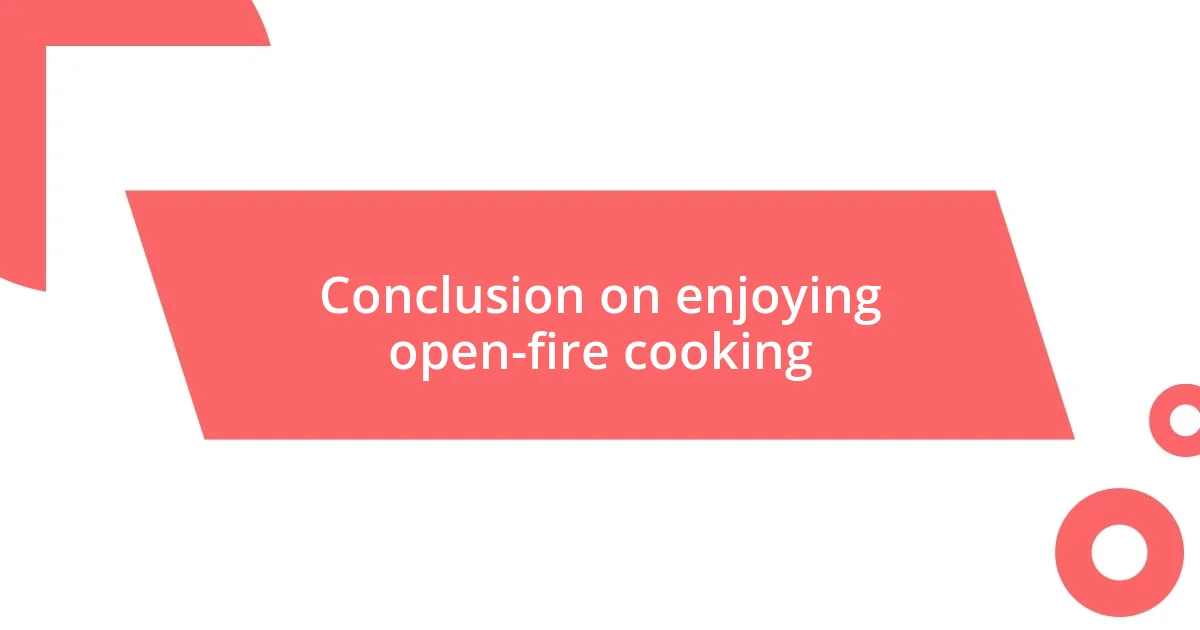
Conclusion on enjoying open-fire cooking
Embracing open-fire cooking has been a transformative experience for me. Each time I gather around the flames, I’m reminded of the communal aspect of this culinary art. The shared laughter, stories, and the intoxicating aroma of food cooking over an open flame create a warm atmosphere that lingers long after the last bite. Isn’t it incredible how food can connect us?
I vividly recall a chilly autumn evening when I decided to invite friends over for an open-fire cookout. As we huddled closer to the fire, roasting skewers of marinated chicken, our conversations blossomed alongside the flames. The ambiance felt charged with energy, creating a bond that was palpable. Moments like these reaffirm my belief that cooking over an open fire isn’t just about the food; it’s about the experiences we create together.
Ultimately, open-fire cooking teaches us to savor both our meals and the company we keep. There’s an undeniable magic in preparing food outdoors, where every sizzle sounds like an invitation to enjoy the moment. I often ask myself, how many of us take the time to relish these little pleasures in life? For me, it’s a reminder that the simplest experiences often leave the most profound impact.
